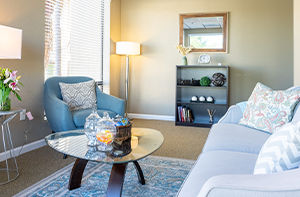Finding the Best Schizoaffective Disorder Treatment Facilities

Schizoaffective disorder is a complex illness that requires multidimensional care tailored to your individual needs. While a large variety of schizoaffective treatment facilities exist, long-term programs that offer in-depth psychological evaluation, personalized psychopharmacology, psychotherapy and experiential therapies, and independent living supports can give you the greatest chance of durable healing. Finding the best schizoaffective treatment facility for you, however, is about more than the technicalities of treatment; it is about finding a place where you feel comfortable and supported.
An hour after Lara was diagnosed with schizoaffective disorder, she was standing at the pharmacy waiting for her new life to begin. The medications prescribed by her psychiatrist, she had been promised, would alleviate her symptoms within weeks. She imagined her life quickly returning to the way it had been before—an ordinary life to which she was desperate to return. Later that night, she looked at her antipsychotics and antidepressants sitting side-by-side on her kitchen counter and felt a sense of hope that she had nearly forgotten how to feel, having spent the last year struggling with growing distress as her symptoms emerged.
But the first medications proved powerless against her condition. So too did the dosage changes and the medications that came after. Some did nothing. Some seemed to partially work, but not well enough to push her illness into remission. Others produced intolerable side effects that made their potential efficacy irrelevant—extreme tremors and difficulty sleeping, just to name a few.
A year after beginning treatment, Lara’s condition was labeled as treatment-resistant. For her, the words felt like a punch in the stomach. “I thought there was no hope for me,” she remembers. “I thought treatment resistance meant that this was it, this was how I was going to live for the rest of my life. And I was getting worse.” Seeing her daughter’s condition deteriorating, Lara’s mother felt there had to be other options than weekly psychiatrist visits that seemed to lead nowhere. “I didn’t want Lara to be hospitalized, as she wasn’t a danger to herself. A hospital didn’t seem like the right environment,” her mother says, “But I did want to find a treatment facility that would offer her more than outpatient care seemed able to.”
Lara’s mother was right; a hospital environment is often not an ideal treatment setting for people with schizoaffective disorder. Rather, the best schizoaffective disorder treatment facilities are typically private residential care programs with a focus on not just short-term, acute care, but long-term stabilization and recovery. This is particularly true in cases where patients have not found meaningful relief from symptoms in outpatient or short-term residential settings, suggesting that their treatment must be more complex than typical first-line interventions. In order to evaluate which facility is best for you, it is essential to understand the unique needs of people with schizoaffective disorder and connect with a program that ensures those needs are met.
In-Depth Psychological Evaluation
The multidimensional symptoms inherent to schizophrenia can make diagnosis a more complicated process than in some other types of mental health disorders. As one research cohort wrote in Psychiatry, “In the absence of clearly delineated features and course of this condition, schizoaffective disorder is apt to be mis/overdiagnosed.” Indeed, researchers have found that clinicians are more likely to diagnose patients with schizoaffective disorder while researchers are more likely to diagnose the same patients with schizophrenia. Some believe this points to diagnostic bias—clinicians may err on the side of the more treatable illness. At the same time, some clinicians may overlook psychotic symptoms altogether, focusing solely on mood symptoms and ultimately misdiagnosing the patient with a mood disorder.
Having a clear and accurate diagnosis is essential to ensure that you receive the right care for your condition—it’s important to confirm that you have schizoaffective disorder in the first place and gain insight into your individual presentation. As such, the treatment program you choose must include an in-depth psychological evaluation process using the most reliable diagnostic tests available combined with clinical interviews in order to develop a full understanding of your symptoms and experiences. Additionally, this evaluation should identify any comorbid conditions that will need to be treated in concert with your primary mental health disorder, as this is essential to creating true and durable healing.
A long-term treatment program lasting 12 months or more is an ideal setting for diagnosis to take place because it allows for close monitoring of your symptoms over time. It can also be valuable to select a treatment program that invites family participation both during the formal diagnostic process and throughout the duration of treatment to provide opportunities for their input into your condition. Often, family members are able to fill in important gaps and offer insight into your experiences that help your treatment team better understand your symptomatology.
Personalized Psychopharmacology
Medication is regarded as the cornerstone to schizoaffective disorder treatment. Depending on the type of schizoaffective disorder you have, psychiatrists will typically use a combination of antipsychotics, mood stabilizers and/or antidepressants in order to address the full range of psychotic and mood symptoms you are experiencing. Monotherapy—or treatment with only one medication—is rarely used, as it is unlikely that a single medication can effectively treat the complex symptoms of the condition. Unfortunately, there is also no single combination of medications that will be effective for all people. Unfortunately, as pointed out in the Journal of Clinical Psychopharmacology, “the complex symptomatology of schizoaffective disorder makes it highly likely that patients will receive substandard management.”
At a high-quality schizoaffective treatment program will be staffed by psychiatrists who have extensive expertise in treating what can be a complicated condition. While there are first-line medication recommendations, not everyone responds to those medications and you may need to explore other options. With a growing number of promising psychotropics entering the market, it’s important for your psychiatrist to be up to date on developments in the field so you can take advantage of new options if appropriate. It’s always critical that your medication plan is targeted toward your specific symptoms and symptom severity and that your reactions to medications are monitored over time in order to fine-tune your plan; the oscillating nature of schizoaffective disorder often means that medication must be tailored in response to current and changing conditions.
A long-term treatment facility can be an ideal space for this to happen, thanks to the length and consistency of monitoring afforded by these programs. Many medications take weeks to take full effect, and evaluating tolerability often takes more time as well. If side effects do occur, your treatment team can make appropriate medication changes or work with you to manage side effects if the medication is otherwise effective, allowing you to enjoy therapeutic benefits without compromising your quality of life. These treatment environments can also support medication adherence, which is often a struggle for people with schizoaffective disorder, in part due to the need for multiple medications.
Psychotherapy and Experiential Therapies
Although medication plays a critical role in the treatment of schizoaffective disorder, it alone is typically not enough to create either full relief from symptoms or true recovery. As Drs. David Kingdon and Douglas Turkington write, “Pharmacologic therapy can leave as many as 60% of psychotic patients with persistent positive and negative symptoms, even when the patients are compliant with their medication instructions.” Mood symptoms may also persist or break through despite high-quality pharmacological interventions. Additionally, the experience of living with schizoaffective disorder, including its impact on self-image, relationships, and overall functionality can produce significant distress that is not resolved via medication. As such, psychotherapy and experiential therapies are essential components of comprehensive schizoaffective disorder treatment.
Via a variety of therapeutic modalities, you can gain insight into your symptoms and experiences while simultaneously creating effective strategies for coping with your schizoaffective disorder and any co-occurring disorders. This may include:
- Challenging damaging thoughts and beliefs and replacing them with healthier alternatives,
- Using mindfulness to improve distress tolerance,
- Reality-testing and normalization of psychosis,
- Relationship skill building to help you form more meaningful bonds with others, and
- Family therapy to forge healthier and more loving connections.
In addition to more traditional forms of psychotherapy, experiential therapies can be integrated into your treatment plan to give you new, novel ways of exploring yourself and the world around you. Throughout these varied modalities, you can not only learn how to more effectively manage psychotic and mood symptoms and find greater self-acceptance, you will also develop a stronger sense of self-determination, purpose, and passion for living.
Long-term schizoaffective disorder facilities offer you the chance to deeply experience a broad spectrum of therapies designed for each stage of recovery in order to create a truly transformative treatment experience. In an immersive environment, you can devote yourself completely to the healing process via consistent participation in meaningful recovery work that cannot be replicated in an outpatient setting. Additionally, the duration of care means that you will have the time necessary to fully integrate new learning, replacing damaging emotional and behavioral patterns on a fundamental level. In other words, these therapies do not simply provide a temporary solution, but become a part of you that you will carry with you long after your time in care, expanding the possibilities for healing.
Looking for the Best Schizoaffective Treatment?
Learn More About Treatment at BrightQuest
Independent Living Supports
Many people with schizoaffective disorder struggle to establish stable, healthy, independent lives due to their symptoms. Unfortunately, outpatient treatment settings can often provide minimal intervention for fostering greater independence, relying primarily on symptom resolution to remove barriers to independent living. However, simply healing from your symptomatology does not automatically imbue you with the skills to be self-sufficient.
The best schizoaffective disorder treatment facilities will be structured in a way that acknowledges the functional difficulties you may experience as the result of your disorder. By providing you with the emotional and practical resources you need to gradually build independence, you can develop strong internal resources to move toward greater self-sufficiency. This includes not only basic self-care activities, such as maintaining your own living space, but also critical social and vocational supports to help you build a support network and a well-rounded, purposeful life.
Because you live with a chronic mental health disorder, part of your new skillset must also include the ability to manage your own treatment, including making appointments and adhering to medication. By gradually transferring these responsibilities to you according to your abilities, your treatment team can guide you toward higher levels of self-reliance while being able to quickly intervene to get you back on track if needed.
Finding the Best Schizoaffective Treatment Facility for You
While there are a number of key features that high-quality schizoaffective disorder treatment facilities must include, it’s ultimately up to you to choose a program that feels right for you. For Lara and her mother, that meant more than looking at a facility’s website; it meant making personal visits to meet the staff and see what life in each program was really like. “There were a number of programs that checked all the boxes, but they just didn’t seem like places I would want to spend a year of my life,” Lara remembers. “I had already spent so much time trying to find recovery and coming up empty, I didn’t want to waste time in a program that wasn’t exactly what I needed. And part of what I needed was to feel that I belonged.” For her mom, being invited to take an active part in the treatment process was also a primary concern. “I knew that family support made a difference in outcomes,” she says. “And I knew my daughter and myself—we would undoubtedly benefit from strong family programming.”
A high-quality treatment program understands that coming to residential care, particularly long-term care, is a significant commitment and that you and your family want to feel welcomed, comfortable, and safe. You want to feel like this is a place you can trust and where you can grow. Don’t be afraid to call and visit the facilities you are considering. After all, this is your health and your life and you deserve to heal surrounded by compassion and love in a place that feels like home.
Treatment at BrightQuest
BrightQuest Treatment Centers provide world-class inpatient schizoaffective disorder treatment and other complex mental illnesses. We know that choosing the right treatment option for yourself or a loved one is difficult. We believe our unique model of care gives our clients the best chance at success.
- Family Integration in Treatment
- Inclusive Therapeutic Community
- Focus on Lasting Behavioral Change
We offer clients the tools, skills, and support necessary to attain greater stability and independence with the confidence and courage to live a healthy, happy, and productive life.






